Managing Chronic Obstructive Pulmonary Disease (COPD): A Case Study
VerifiedAdded on 2023/06/07
|11
|3361
|107
AI Summary
This case study presents a patient with COPD and discusses potential health concerns, education topics, strategies for educating clients, and cultural beliefs that influence patient interaction. The patient requires education related to quitting smoking and occupational hazard. The paper suggests using powerpoint audio-video tutorial to static PDF presented by using tablets or projectors for educating patients. The verbal and non-verbal demonstration can be the method to educate the patient and his wife for wearing the mask in workplaces.
Contribute Materials
Your contribution can guide someone’s learning journey. Share your
documents today.
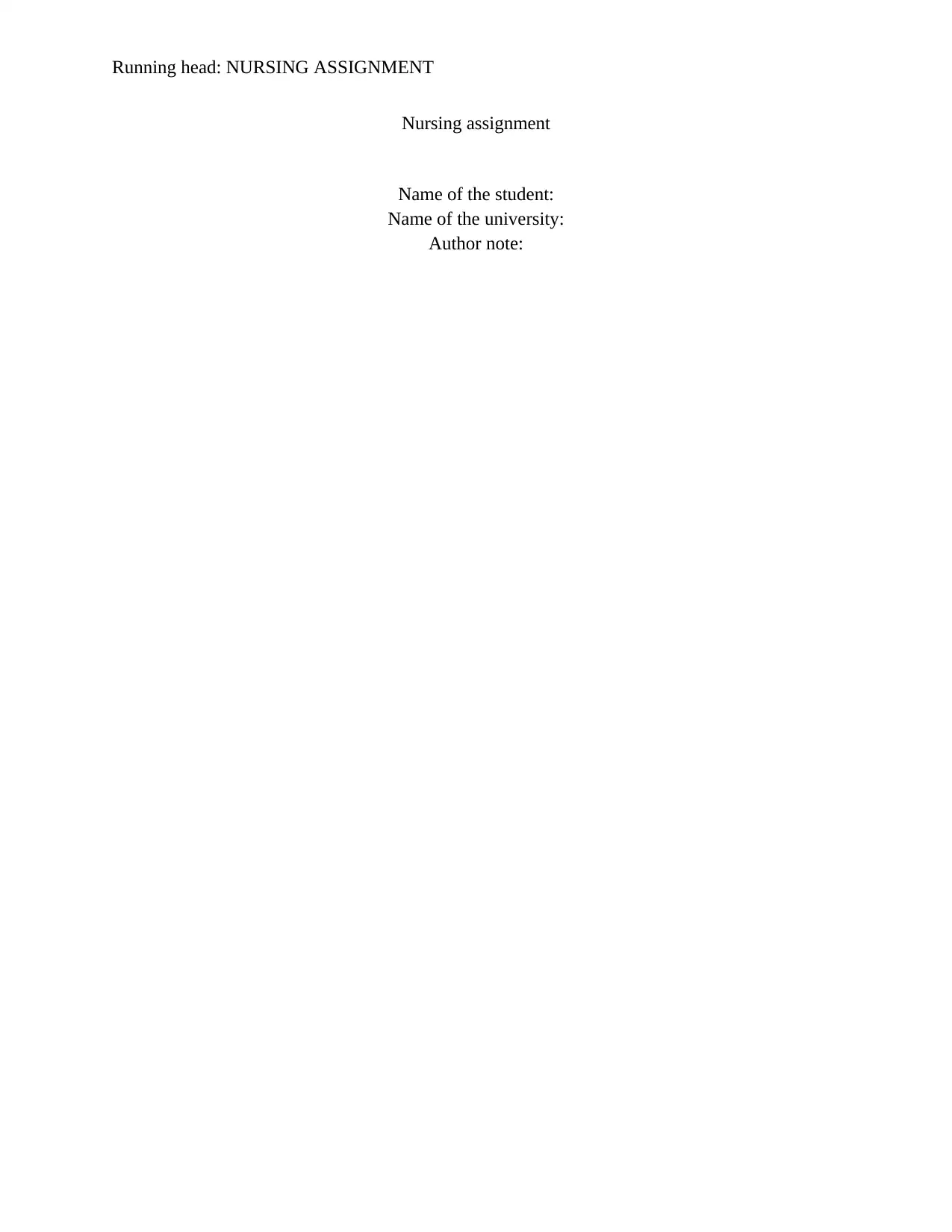
Running head: NURSING ASSIGNMENT
Nursing assignment
Name of the student:
Name of the university:
Author note:
Nursing assignment
Name of the student:
Name of the university:
Author note:
Secure Best Marks with AI Grader
Need help grading? Try our AI Grader for instant feedback on your assignments.
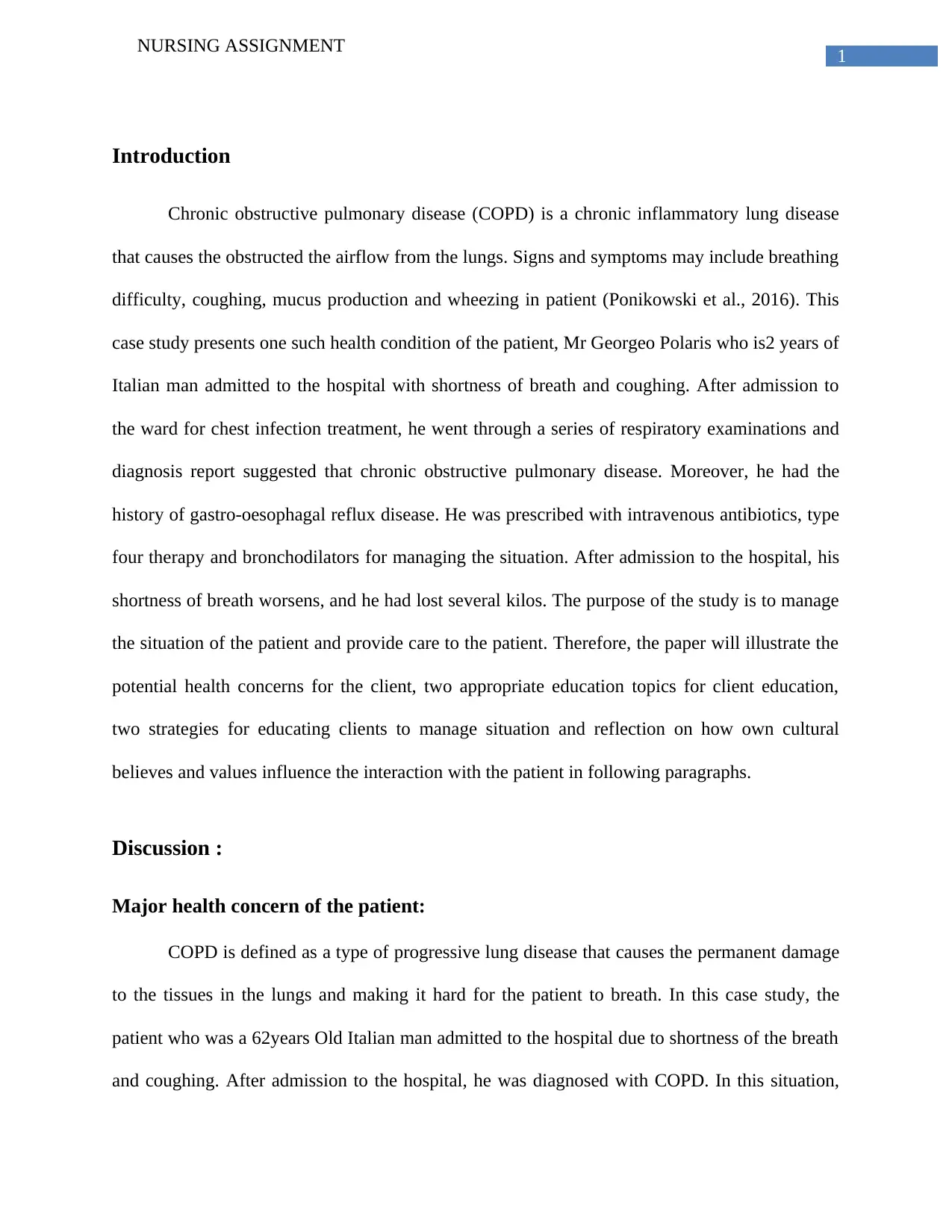
1
NURSING ASSIGNMENT
Introduction
Chronic obstructive pulmonary disease (COPD) is a chronic inflammatory lung disease
that causes the obstructed the airflow from the lungs. Signs and symptoms may include breathing
difficulty, coughing, mucus production and wheezing in patient (Ponikowski et al., 2016). This
case study presents one such health condition of the patient, Mr Georgeo Polaris who is2 years of
Italian man admitted to the hospital with shortness of breath and coughing. After admission to
the ward for chest infection treatment, he went through a series of respiratory examinations and
diagnosis report suggested that chronic obstructive pulmonary disease. Moreover, he had the
history of gastro-oesophagal reflux disease. He was prescribed with intravenous antibiotics, type
four therapy and bronchodilators for managing the situation. After admission to the hospital, his
shortness of breath worsens, and he had lost several kilos. The purpose of the study is to manage
the situation of the patient and provide care to the patient. Therefore, the paper will illustrate the
potential health concerns for the client, two appropriate education topics for client education,
two strategies for educating clients to manage situation and reflection on how own cultural
believes and values influence the interaction with the patient in following paragraphs.
Discussion :
Major health concern of the patient:
COPD is defined as a type of progressive lung disease that causes the permanent damage
to the tissues in the lungs and making it hard for the patient to breath. In this case study, the
patient who was a 62years Old Italian man admitted to the hospital due to shortness of the breath
and coughing. After admission to the hospital, he was diagnosed with COPD. In this situation,
NURSING ASSIGNMENT
Introduction
Chronic obstructive pulmonary disease (COPD) is a chronic inflammatory lung disease
that causes the obstructed the airflow from the lungs. Signs and symptoms may include breathing
difficulty, coughing, mucus production and wheezing in patient (Ponikowski et al., 2016). This
case study presents one such health condition of the patient, Mr Georgeo Polaris who is2 years of
Italian man admitted to the hospital with shortness of breath and coughing. After admission to
the ward for chest infection treatment, he went through a series of respiratory examinations and
diagnosis report suggested that chronic obstructive pulmonary disease. Moreover, he had the
history of gastro-oesophagal reflux disease. He was prescribed with intravenous antibiotics, type
four therapy and bronchodilators for managing the situation. After admission to the hospital, his
shortness of breath worsens, and he had lost several kilos. The purpose of the study is to manage
the situation of the patient and provide care to the patient. Therefore, the paper will illustrate the
potential health concerns for the client, two appropriate education topics for client education,
two strategies for educating clients to manage situation and reflection on how own cultural
believes and values influence the interaction with the patient in following paragraphs.
Discussion :
Major health concern of the patient:
COPD is defined as a type of progressive lung disease that causes the permanent damage
to the tissues in the lungs and making it hard for the patient to breath. In this case study, the
patient who was a 62years Old Italian man admitted to the hospital due to shortness of the breath
and coughing. After admission to the hospital, he was diagnosed with COPD. In this situation,
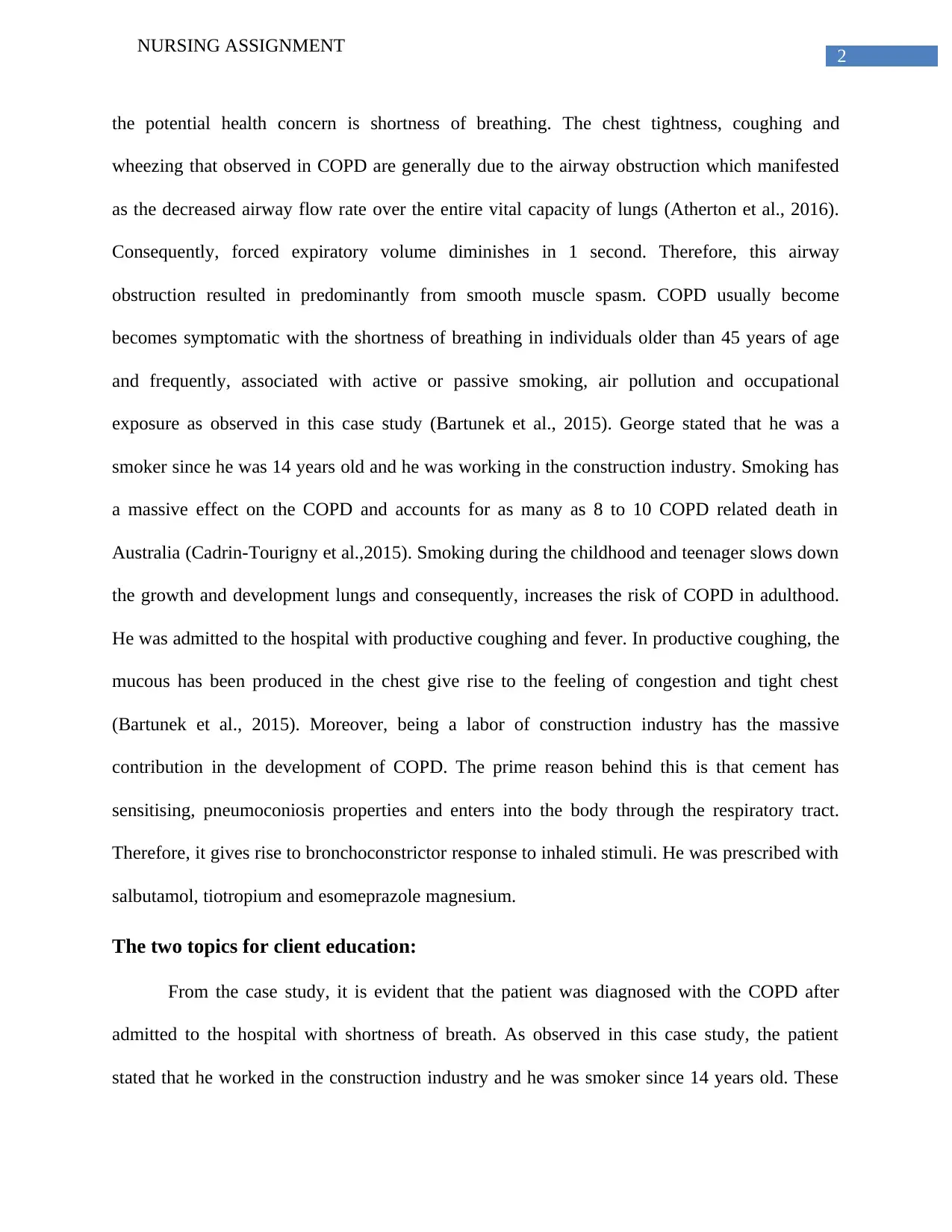
2
NURSING ASSIGNMENT
the potential health concern is shortness of breathing. The chest tightness, coughing and
wheezing that observed in COPD are generally due to the airway obstruction which manifested
as the decreased airway flow rate over the entire vital capacity of lungs (Atherton et al., 2016).
Consequently, forced expiratory volume diminishes in 1 second. Therefore, this airway
obstruction resulted in predominantly from smooth muscle spasm. COPD usually become
becomes symptomatic with the shortness of breathing in individuals older than 45 years of age
and frequently, associated with active or passive smoking, air pollution and occupational
exposure as observed in this case study (Bartunek et al., 2015). George stated that he was a
smoker since he was 14 years old and he was working in the construction industry. Smoking has
a massive effect on the COPD and accounts for as many as 8 to 10 COPD related death in
Australia (Cadrin-Tourigny et al.,2015). Smoking during the childhood and teenager slows down
the growth and development lungs and consequently, increases the risk of COPD in adulthood.
He was admitted to the hospital with productive coughing and fever. In productive coughing, the
mucous has been produced in the chest give rise to the feeling of congestion and tight chest
(Bartunek et al., 2015). Moreover, being a labor of construction industry has the massive
contribution in the development of COPD. The prime reason behind this is that cement has
sensitising, pneumoconiosis properties and enters into the body through the respiratory tract.
Therefore, it gives rise to bronchoconstrictor response to inhaled stimuli. He was prescribed with
salbutamol, tiotropium and esomeprazole magnesium.
The two topics for client education:
From the case study, it is evident that the patient was diagnosed with the COPD after
admitted to the hospital with shortness of breath. As observed in this case study, the patient
stated that he worked in the construction industry and he was smoker since 14 years old. These
NURSING ASSIGNMENT
the potential health concern is shortness of breathing. The chest tightness, coughing and
wheezing that observed in COPD are generally due to the airway obstruction which manifested
as the decreased airway flow rate over the entire vital capacity of lungs (Atherton et al., 2016).
Consequently, forced expiratory volume diminishes in 1 second. Therefore, this airway
obstruction resulted in predominantly from smooth muscle spasm. COPD usually become
becomes symptomatic with the shortness of breathing in individuals older than 45 years of age
and frequently, associated with active or passive smoking, air pollution and occupational
exposure as observed in this case study (Bartunek et al., 2015). George stated that he was a
smoker since he was 14 years old and he was working in the construction industry. Smoking has
a massive effect on the COPD and accounts for as many as 8 to 10 COPD related death in
Australia (Cadrin-Tourigny et al.,2015). Smoking during the childhood and teenager slows down
the growth and development lungs and consequently, increases the risk of COPD in adulthood.
He was admitted to the hospital with productive coughing and fever. In productive coughing, the
mucous has been produced in the chest give rise to the feeling of congestion and tight chest
(Bartunek et al., 2015). Moreover, being a labor of construction industry has the massive
contribution in the development of COPD. The prime reason behind this is that cement has
sensitising, pneumoconiosis properties and enters into the body through the respiratory tract.
Therefore, it gives rise to bronchoconstrictor response to inhaled stimuli. He was prescribed with
salbutamol, tiotropium and esomeprazole magnesium.
The two topics for client education:
From the case study, it is evident that the patient was diagnosed with the COPD after
admitted to the hospital with shortness of breath. As observed in this case study, the patient
stated that he worked in the construction industry and he was smoker since 14 years old. These

3
NURSING ASSIGNMENT
two factors majorly contributed to the development of the COPD. In such situation, the first
factor for client education would be how smoking has the massive impact on the progression of
COPD and quitting smoking has immediate and substantial health benefits on a patient
(Daskalopoulou et al., 2015). Recent studies suggest that despite the nature of COPD is wide
spreading; cessation of smoking has remarkable health benefits to a smoker suffering from the
disease. In the slow progression of the disease, quit smoking leads to the improvement in
symptoms such as productive coughing and wheezing. In severe cases, quitting smoking slowly
stabilizes the shortness of breath in the patient and rapidly reduces the frequency of
coughing(Carthon, Lasater, Sloane & Kutney-Lee, 2015). Smoking cessations slow down the
decline in the forced expiratory volume of air expelled in one second and reduce the risk of
bacterial colonisation by improving the natural defence mechanism of the body (Jiménez-Ruiz et
al., 2015). Therefore, to improve the health conditions, clients need to have an appropriate
education about the disease. In this case, study, since the patient was working on the construction
industry, how occupational hazard influence the progression of conditions should be another
topic for client education. Occupational exposure has been shown to associated with COPD.
However, it is not possible to quite a job to slow down the progression of the disease. Hence, the
use of a simple face mask can slows down the disease progression since it prevents the entry of
fine cement dust into the respiratory tract (Harris et al., 2017). The use of nebulised salbutamol
in working place can slow down the progression of the disease. Moreover, washing hands,
avoiding the crowded area and staying hydrated significantly reduced the COPD.
Quitting smoking gradually slows down the progression of COPD by stabilizing the
shortness of the breathing.After gaining the sound knowledge about the quitting smoking and its
health benefits, the patient would be able to manage the disease (Riley, 2015). During the
NURSING ASSIGNMENT
two factors majorly contributed to the development of the COPD. In such situation, the first
factor for client education would be how smoking has the massive impact on the progression of
COPD and quitting smoking has immediate and substantial health benefits on a patient
(Daskalopoulou et al., 2015). Recent studies suggest that despite the nature of COPD is wide
spreading; cessation of smoking has remarkable health benefits to a smoker suffering from the
disease. In the slow progression of the disease, quit smoking leads to the improvement in
symptoms such as productive coughing and wheezing. In severe cases, quitting smoking slowly
stabilizes the shortness of breath in the patient and rapidly reduces the frequency of
coughing(Carthon, Lasater, Sloane & Kutney-Lee, 2015). Smoking cessations slow down the
decline in the forced expiratory volume of air expelled in one second and reduce the risk of
bacterial colonisation by improving the natural defence mechanism of the body (Jiménez-Ruiz et
al., 2015). Therefore, to improve the health conditions, clients need to have an appropriate
education about the disease. In this case, study, since the patient was working on the construction
industry, how occupational hazard influence the progression of conditions should be another
topic for client education. Occupational exposure has been shown to associated with COPD.
However, it is not possible to quite a job to slow down the progression of the disease. Hence, the
use of a simple face mask can slows down the disease progression since it prevents the entry of
fine cement dust into the respiratory tract (Harris et al., 2017). The use of nebulised salbutamol
in working place can slow down the progression of the disease. Moreover, washing hands,
avoiding the crowded area and staying hydrated significantly reduced the COPD.
Quitting smoking gradually slows down the progression of COPD by stabilizing the
shortness of the breathing.After gaining the sound knowledge about the quitting smoking and its
health benefits, the patient would be able to manage the disease (Riley, 2015). During the
Secure Best Marks with AI Grader
Need help grading? Try our AI Grader for instant feedback on your assignments.
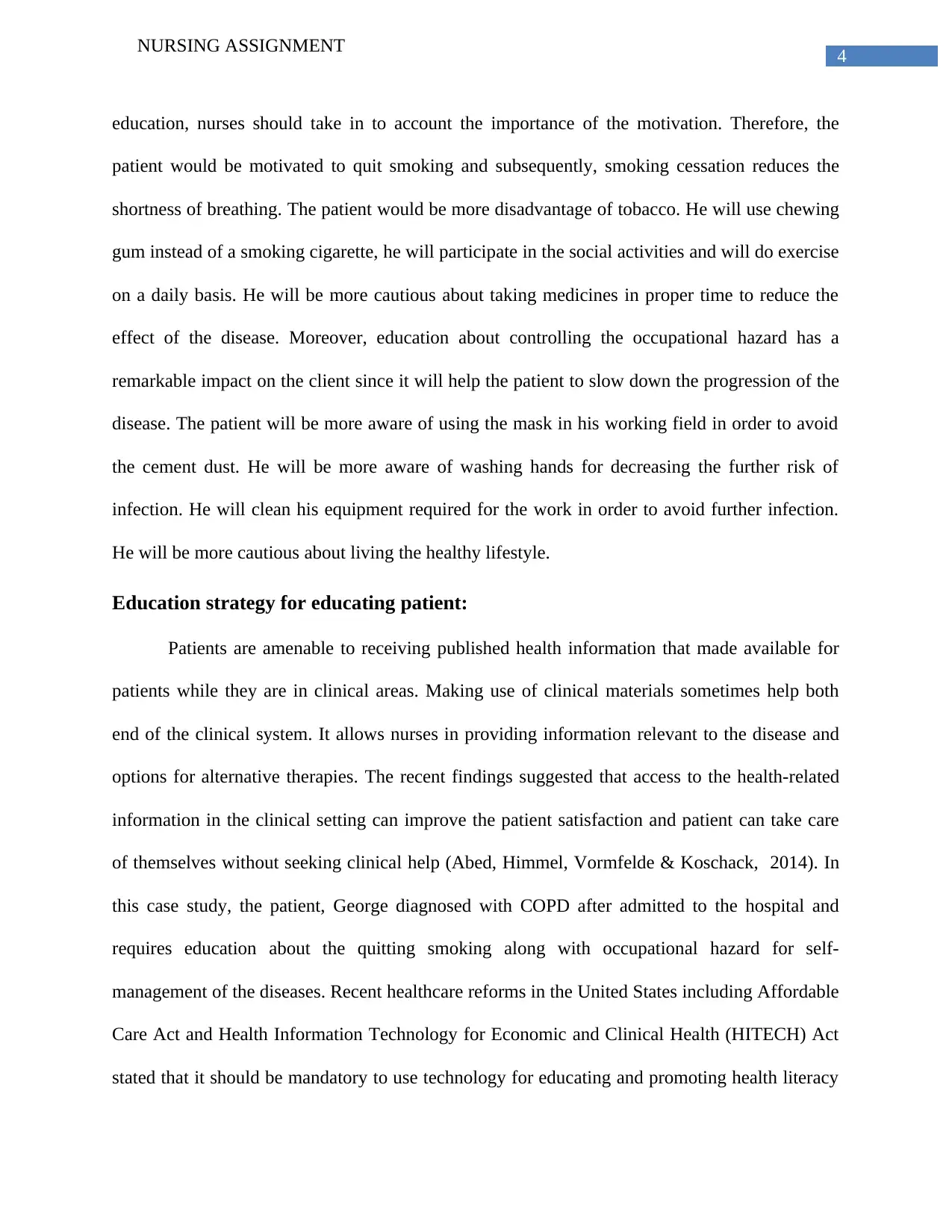
4
NURSING ASSIGNMENT
education, nurses should take in to account the importance of the motivation. Therefore, the
patient would be motivated to quit smoking and subsequently, smoking cessation reduces the
shortness of breathing. The patient would be more disadvantage of tobacco. He will use chewing
gum instead of a smoking cigarette, he will participate in the social activities and will do exercise
on a daily basis. He will be more cautious about taking medicines in proper time to reduce the
effect of the disease. Moreover, education about controlling the occupational hazard has a
remarkable impact on the client since it will help the patient to slow down the progression of the
disease. The patient will be more aware of using the mask in his working field in order to avoid
the cement dust. He will be more aware of washing hands for decreasing the further risk of
infection. He will clean his equipment required for the work in order to avoid further infection.
He will be more cautious about living the healthy lifestyle.
Education strategy for educating patient:
Patients are amenable to receiving published health information that made available for
patients while they are in clinical areas. Making use of clinical materials sometimes help both
end of the clinical system. It allows nurses in providing information relevant to the disease and
options for alternative therapies. The recent findings suggested that access to the health-related
information in the clinical setting can improve the patient satisfaction and patient can take care
of themselves without seeking clinical help (Abed, Himmel, Vormfelde & Koschack, 2014). In
this case study, the patient, George diagnosed with COPD after admitted to the hospital and
requires education about the quitting smoking along with occupational hazard for self-
management of the diseases. Recent healthcare reforms in the United States including Affordable
Care Act and Health Information Technology for Economic and Clinical Health (HITECH) Act
stated that it should be mandatory to use technology for educating and promoting health literacy
NURSING ASSIGNMENT
education, nurses should take in to account the importance of the motivation. Therefore, the
patient would be motivated to quit smoking and subsequently, smoking cessation reduces the
shortness of breathing. The patient would be more disadvantage of tobacco. He will use chewing
gum instead of a smoking cigarette, he will participate in the social activities and will do exercise
on a daily basis. He will be more cautious about taking medicines in proper time to reduce the
effect of the disease. Moreover, education about controlling the occupational hazard has a
remarkable impact on the client since it will help the patient to slow down the progression of the
disease. The patient will be more aware of using the mask in his working field in order to avoid
the cement dust. He will be more aware of washing hands for decreasing the further risk of
infection. He will clean his equipment required for the work in order to avoid further infection.
He will be more cautious about living the healthy lifestyle.
Education strategy for educating patient:
Patients are amenable to receiving published health information that made available for
patients while they are in clinical areas. Making use of clinical materials sometimes help both
end of the clinical system. It allows nurses in providing information relevant to the disease and
options for alternative therapies. The recent findings suggested that access to the health-related
information in the clinical setting can improve the patient satisfaction and patient can take care
of themselves without seeking clinical help (Abed, Himmel, Vormfelde & Koschack, 2014). In
this case study, the patient, George diagnosed with COPD after admitted to the hospital and
requires education about the quitting smoking along with occupational hazard for self-
management of the diseases. Recent healthcare reforms in the United States including Affordable
Care Act and Health Information Technology for Economic and Clinical Health (HITECH) Act
stated that it should be mandatory to use technology for educating and promoting health literacy
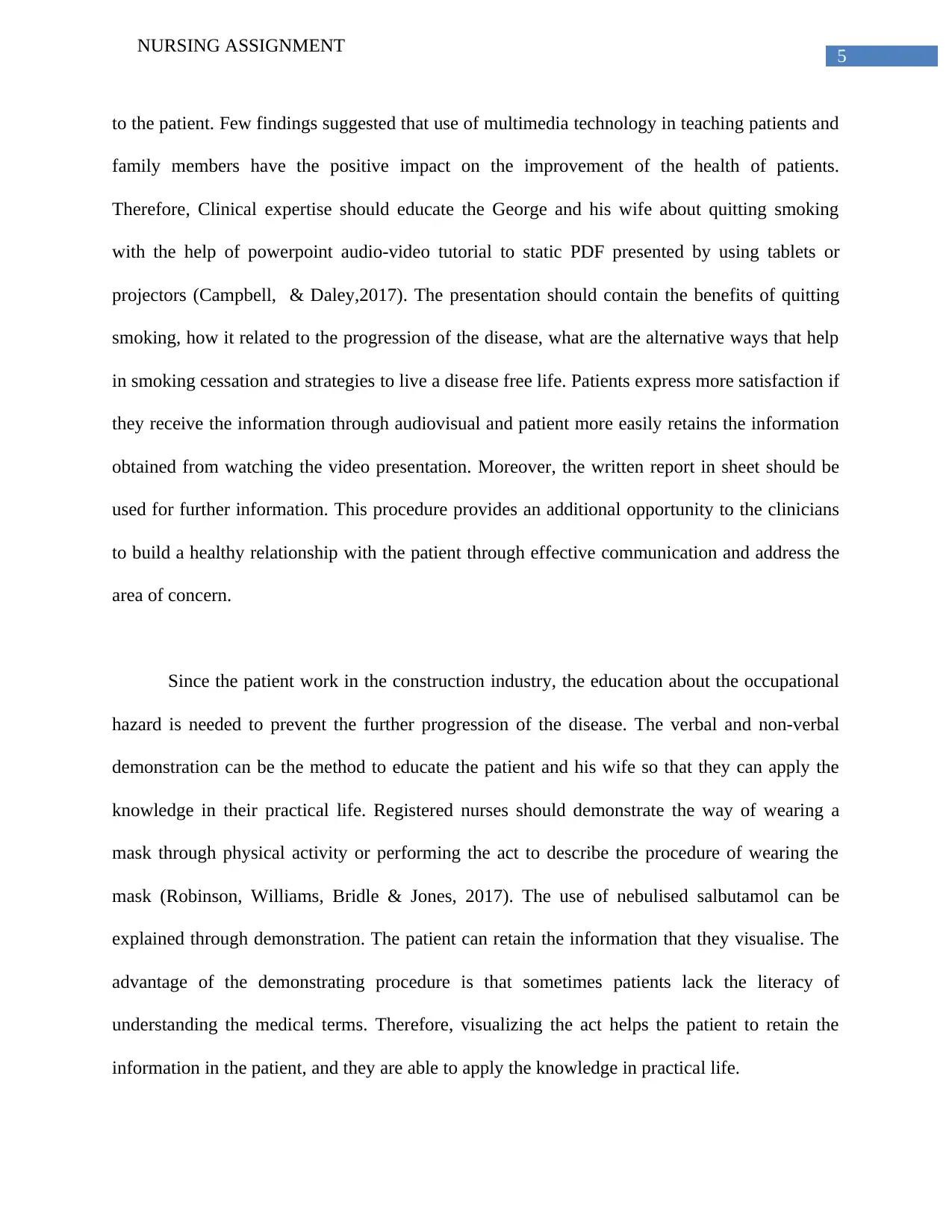
5
NURSING ASSIGNMENT
to the patient. Few findings suggested that use of multimedia technology in teaching patients and
family members have the positive impact on the improvement of the health of patients.
Therefore, Clinical expertise should educate the George and his wife about quitting smoking
with the help of powerpoint audio-video tutorial to static PDF presented by using tablets or
projectors (Campbell, & Daley,2017). The presentation should contain the benefits of quitting
smoking, how it related to the progression of the disease, what are the alternative ways that help
in smoking cessation and strategies to live a disease free life. Patients express more satisfaction if
they receive the information through audiovisual and patient more easily retains the information
obtained from watching the video presentation. Moreover, the written report in sheet should be
used for further information. This procedure provides an additional opportunity to the clinicians
to build a healthy relationship with the patient through effective communication and address the
area of concern.
Since the patient work in the construction industry, the education about the occupational
hazard is needed to prevent the further progression of the disease. The verbal and non-verbal
demonstration can be the method to educate the patient and his wife so that they can apply the
knowledge in their practical life. Registered nurses should demonstrate the way of wearing a
mask through physical activity or performing the act to describe the procedure of wearing the
mask (Robinson, Williams, Bridle & Jones, 2017). The use of nebulised salbutamol can be
explained through demonstration. The patient can retain the information that they visualise. The
advantage of the demonstrating procedure is that sometimes patients lack the literacy of
understanding the medical terms. Therefore, visualizing the act helps the patient to retain the
information in the patient, and they are able to apply the knowledge in practical life.
NURSING ASSIGNMENT
to the patient. Few findings suggested that use of multimedia technology in teaching patients and
family members have the positive impact on the improvement of the health of patients.
Therefore, Clinical expertise should educate the George and his wife about quitting smoking
with the help of powerpoint audio-video tutorial to static PDF presented by using tablets or
projectors (Campbell, & Daley,2017). The presentation should contain the benefits of quitting
smoking, how it related to the progression of the disease, what are the alternative ways that help
in smoking cessation and strategies to live a disease free life. Patients express more satisfaction if
they receive the information through audiovisual and patient more easily retains the information
obtained from watching the video presentation. Moreover, the written report in sheet should be
used for further information. This procedure provides an additional opportunity to the clinicians
to build a healthy relationship with the patient through effective communication and address the
area of concern.
Since the patient work in the construction industry, the education about the occupational
hazard is needed to prevent the further progression of the disease. The verbal and non-verbal
demonstration can be the method to educate the patient and his wife so that they can apply the
knowledge in their practical life. Registered nurses should demonstrate the way of wearing a
mask through physical activity or performing the act to describe the procedure of wearing the
mask (Robinson, Williams, Bridle & Jones, 2017). The use of nebulised salbutamol can be
explained through demonstration. The patient can retain the information that they visualise. The
advantage of the demonstrating procedure is that sometimes patients lack the literacy of
understanding the medical terms. Therefore, visualizing the act helps the patient to retain the
information in the patient, and they are able to apply the knowledge in practical life.
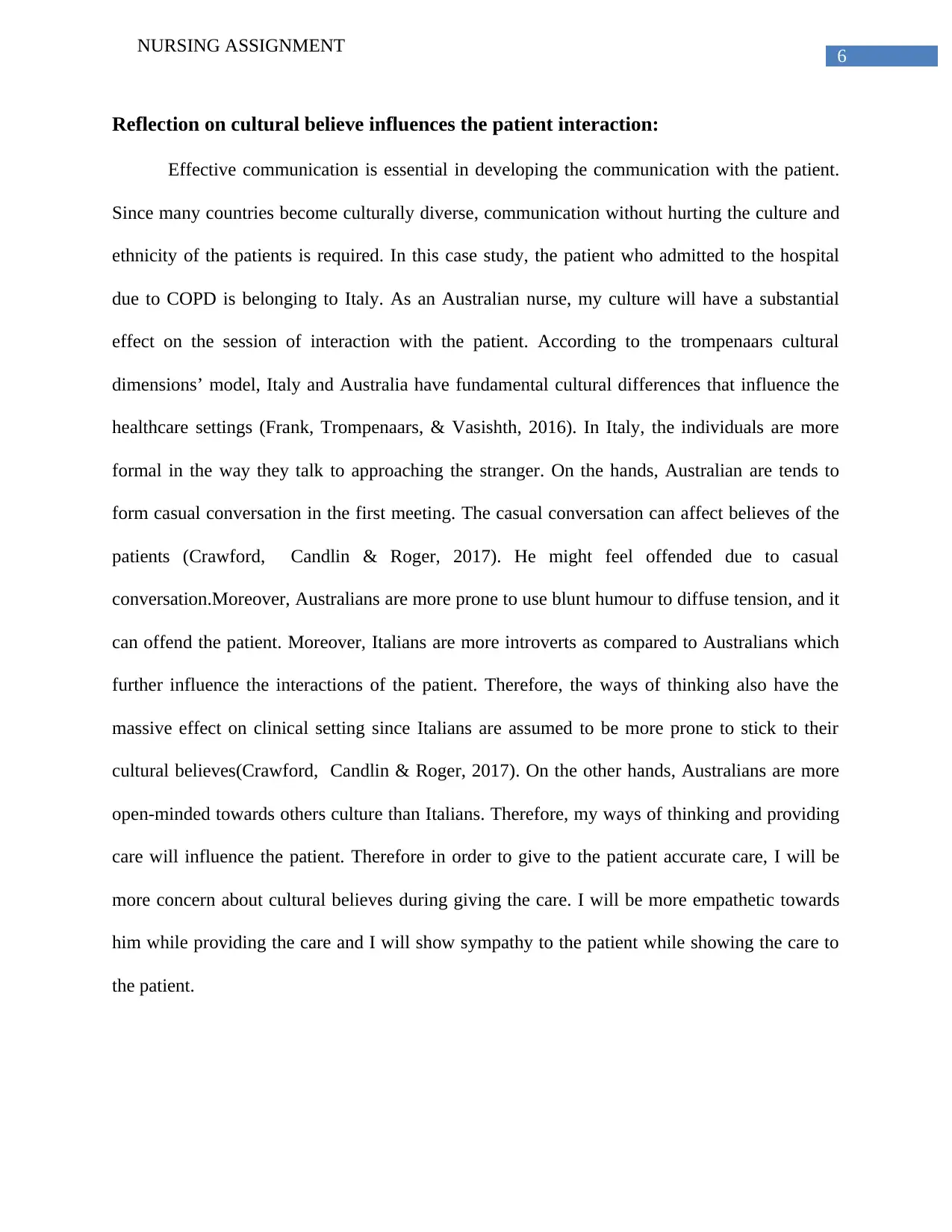
6
NURSING ASSIGNMENT
Reflection on cultural believe influences the patient interaction:
Effective communication is essential in developing the communication with the patient.
Since many countries become culturally diverse, communication without hurting the culture and
ethnicity of the patients is required. In this case study, the patient who admitted to the hospital
due to COPD is belonging to Italy. As an Australian nurse, my culture will have a substantial
effect on the session of interaction with the patient. According to the trompenaars cultural
dimensions’ model, Italy and Australia have fundamental cultural differences that influence the
healthcare settings (Frank, Trompenaars, & Vasishth, 2016). In Italy, the individuals are more
formal in the way they talk to approaching the stranger. On the hands, Australian are tends to
form casual conversation in the first meeting. The casual conversation can affect believes of the
patients (Crawford, Candlin & Roger, 2017). He might feel offended due to casual
conversation.Moreover, Australians are more prone to use blunt humour to diffuse tension, and it
can offend the patient. Moreover, Italians are more introverts as compared to Australians which
further influence the interactions of the patient. Therefore, the ways of thinking also have the
massive effect on clinical setting since Italians are assumed to be more prone to stick to their
cultural believes(Crawford, Candlin & Roger, 2017). On the other hands, Australians are more
open-minded towards others culture than Italians. Therefore, my ways of thinking and providing
care will influence the patient. Therefore in order to give to the patient accurate care, I will be
more concern about cultural believes during giving the care. I will be more empathetic towards
him while providing the care and I will show sympathy to the patient while showing the care to
the patient.
NURSING ASSIGNMENT
Reflection on cultural believe influences the patient interaction:
Effective communication is essential in developing the communication with the patient.
Since many countries become culturally diverse, communication without hurting the culture and
ethnicity of the patients is required. In this case study, the patient who admitted to the hospital
due to COPD is belonging to Italy. As an Australian nurse, my culture will have a substantial
effect on the session of interaction with the patient. According to the trompenaars cultural
dimensions’ model, Italy and Australia have fundamental cultural differences that influence the
healthcare settings (Frank, Trompenaars, & Vasishth, 2016). In Italy, the individuals are more
formal in the way they talk to approaching the stranger. On the hands, Australian are tends to
form casual conversation in the first meeting. The casual conversation can affect believes of the
patients (Crawford, Candlin & Roger, 2017). He might feel offended due to casual
conversation.Moreover, Australians are more prone to use blunt humour to diffuse tension, and it
can offend the patient. Moreover, Italians are more introverts as compared to Australians which
further influence the interactions of the patient. Therefore, the ways of thinking also have the
massive effect on clinical setting since Italians are assumed to be more prone to stick to their
cultural believes(Crawford, Candlin & Roger, 2017). On the other hands, Australians are more
open-minded towards others culture than Italians. Therefore, my ways of thinking and providing
care will influence the patient. Therefore in order to give to the patient accurate care, I will be
more concern about cultural believes during giving the care. I will be more empathetic towards
him while providing the care and I will show sympathy to the patient while showing the care to
the patient.
Paraphrase This Document
Need a fresh take? Get an instant paraphrase of this document with our AI Paraphraser

7
NURSING ASSIGNMENT
Conclusion :
From the analysis of the case study, it can be concluded that COPD is one of the leading
cause of death around the globe. In this case study, In this case study, the patient who was a
62years Old Italian man admitted to the hospital due to shortness of the breath and coughing.
After admission to the hospital, he was diagnosed with COPD. He had the history of the
Gastroesophageal reflux disease. In such conditions, the primary health concern is shortness of
breath, and the patient requires the educations related to the quit smoking and occupational
hazard. Quit smoking has the enormous effect on disease since it slows down the progression of
the disease. Moreover, using the mask in the workplace also reduced the occupational hazard of
the disease. Therefore, methods of educating patients can be powerpoint audio-video tutorial to
static PDF presented by using tablets or projectors. Patients express more satisfaction if they
receive the information through audiovisual and patient more easily retains the information
obtained by watching the video presentation. The verbal and non-verbal demonstration can be
the method to educate the patient and his wife for wearing the mask in workplaces. Moreover,
the paper also reflects on how cultural beliefs influence the interaction between nurse and patient
during the episode of providing care.
NURSING ASSIGNMENT
Conclusion :
From the analysis of the case study, it can be concluded that COPD is one of the leading
cause of death around the globe. In this case study, In this case study, the patient who was a
62years Old Italian man admitted to the hospital due to shortness of the breath and coughing.
After admission to the hospital, he was diagnosed with COPD. He had the history of the
Gastroesophageal reflux disease. In such conditions, the primary health concern is shortness of
breath, and the patient requires the educations related to the quit smoking and occupational
hazard. Quit smoking has the enormous effect on disease since it slows down the progression of
the disease. Moreover, using the mask in the workplace also reduced the occupational hazard of
the disease. Therefore, methods of educating patients can be powerpoint audio-video tutorial to
static PDF presented by using tablets or projectors. Patients express more satisfaction if they
receive the information through audiovisual and patient more easily retains the information
obtained by watching the video presentation. The verbal and non-verbal demonstration can be
the method to educate the patient and his wife for wearing the mask in workplaces. Moreover,
the paper also reflects on how cultural beliefs influence the interaction between nurse and patient
during the episode of providing care.
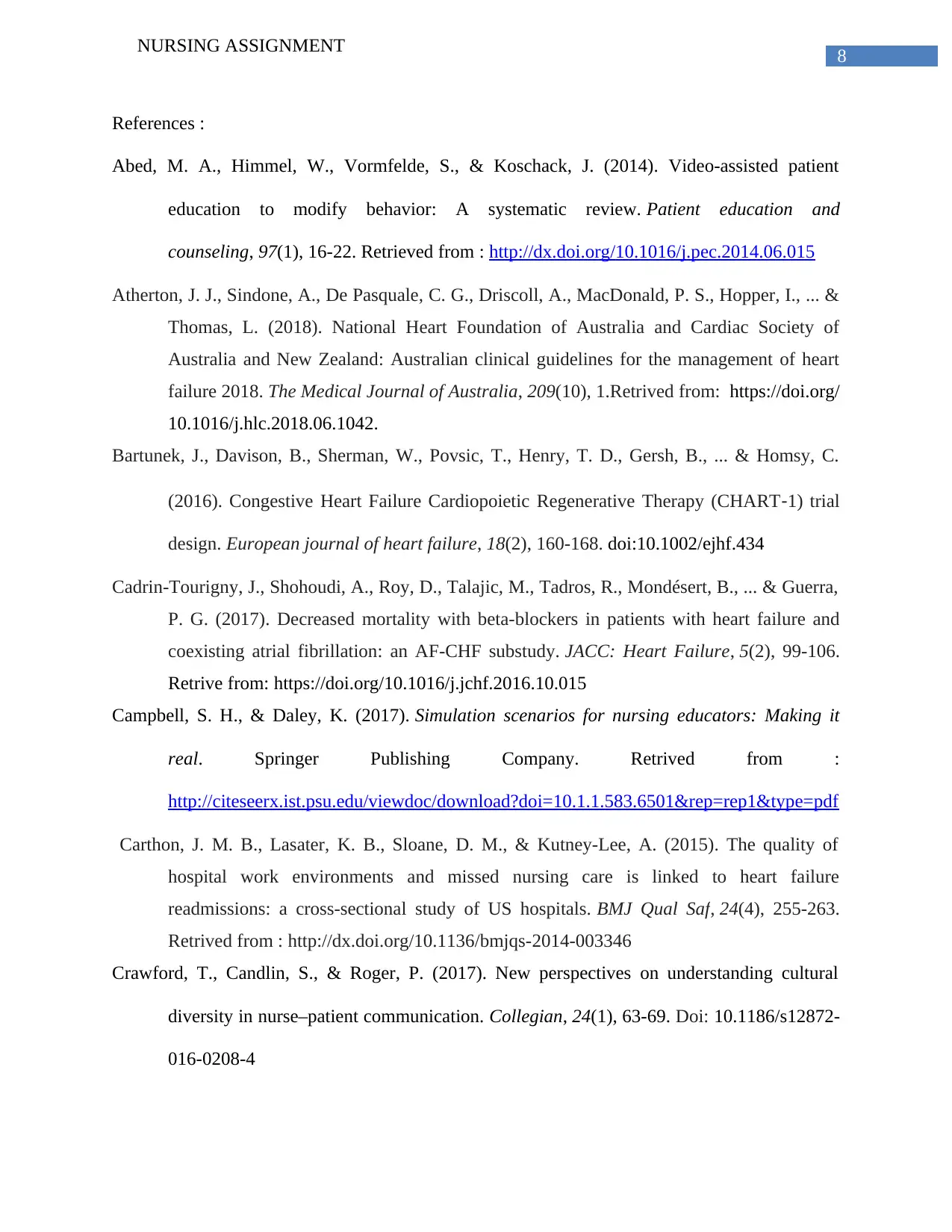
8
NURSING ASSIGNMENT
References :
Abed, M. A., Himmel, W., Vormfelde, S., & Koschack, J. (2014). Video-assisted patient
education to modify behavior: A systematic review. Patient education and
counseling, 97(1), 16-22. Retrieved from : http://dx.doi.org/10.1016/j.pec.2014.06.015
Atherton, J. J., Sindone, A., De Pasquale, C. G., Driscoll, A., MacDonald, P. S., Hopper, I., ... &
Thomas, L. (2018). National Heart Foundation of Australia and Cardiac Society of
Australia and New Zealand: Australian clinical guidelines for the management of heart
failure 2018. The Medical Journal of Australia, 209(10), 1.Retrived from: https://doi.org/
10.1016/j.hlc.2018.06.1042.
Bartunek, J., Davison, B., Sherman, W., Povsic, T., Henry, T. D., Gersh, B., ... & Homsy, C.
(2016). Congestive Heart Failure Cardiopoietic Regenerative Therapy (CHART‐1) trial
design. European journal of heart failure, 18(2), 160-168. doi:10.1002/ejhf.434
Cadrin-Tourigny, J., Shohoudi, A., Roy, D., Talajic, M., Tadros, R., Mondésert, B., ... & Guerra,
P. G. (2017). Decreased mortality with beta-blockers in patients with heart failure and
coexisting atrial fibrillation: an AF-CHF substudy. JACC: Heart Failure, 5(2), 99-106.
Retrive from: https://doi.org/10.1016/j.jchf.2016.10.015
Campbell, S. H., & Daley, K. (2017). Simulation scenarios for nursing educators: Making it
real. Springer Publishing Company. Retrived from :
http://citeseerx.ist.psu.edu/viewdoc/download?doi=10.1.1.583.6501&rep=rep1&type=pdf
Carthon, J. M. B., Lasater, K. B., Sloane, D. M., & Kutney-Lee, A. (2015). The quality of
hospital work environments and missed nursing care is linked to heart failure
readmissions: a cross-sectional study of US hospitals. BMJ Qual Saf, 24(4), 255-263.
Retrived from : http://dx.doi.org/10.1136/bmjqs-2014-003346
Crawford, T., Candlin, S., & Roger, P. (2017). New perspectives on understanding cultural
diversity in nurse–patient communication. Collegian, 24(1), 63-69. Doi: 10.1186/s12872-
016-0208-4
NURSING ASSIGNMENT
References :
Abed, M. A., Himmel, W., Vormfelde, S., & Koschack, J. (2014). Video-assisted patient
education to modify behavior: A systematic review. Patient education and
counseling, 97(1), 16-22. Retrieved from : http://dx.doi.org/10.1016/j.pec.2014.06.015
Atherton, J. J., Sindone, A., De Pasquale, C. G., Driscoll, A., MacDonald, P. S., Hopper, I., ... &
Thomas, L. (2018). National Heart Foundation of Australia and Cardiac Society of
Australia and New Zealand: Australian clinical guidelines for the management of heart
failure 2018. The Medical Journal of Australia, 209(10), 1.Retrived from: https://doi.org/
10.1016/j.hlc.2018.06.1042.
Bartunek, J., Davison, B., Sherman, W., Povsic, T., Henry, T. D., Gersh, B., ... & Homsy, C.
(2016). Congestive Heart Failure Cardiopoietic Regenerative Therapy (CHART‐1) trial
design. European journal of heart failure, 18(2), 160-168. doi:10.1002/ejhf.434
Cadrin-Tourigny, J., Shohoudi, A., Roy, D., Talajic, M., Tadros, R., Mondésert, B., ... & Guerra,
P. G. (2017). Decreased mortality with beta-blockers in patients with heart failure and
coexisting atrial fibrillation: an AF-CHF substudy. JACC: Heart Failure, 5(2), 99-106.
Retrive from: https://doi.org/10.1016/j.jchf.2016.10.015
Campbell, S. H., & Daley, K. (2017). Simulation scenarios for nursing educators: Making it
real. Springer Publishing Company. Retrived from :
http://citeseerx.ist.psu.edu/viewdoc/download?doi=10.1.1.583.6501&rep=rep1&type=pdf
Carthon, J. M. B., Lasater, K. B., Sloane, D. M., & Kutney-Lee, A. (2015). The quality of
hospital work environments and missed nursing care is linked to heart failure
readmissions: a cross-sectional study of US hospitals. BMJ Qual Saf, 24(4), 255-263.
Retrived from : http://dx.doi.org/10.1136/bmjqs-2014-003346
Crawford, T., Candlin, S., & Roger, P. (2017). New perspectives on understanding cultural
diversity in nurse–patient communication. Collegian, 24(1), 63-69. Doi: 10.1186/s12872-
016-0208-4
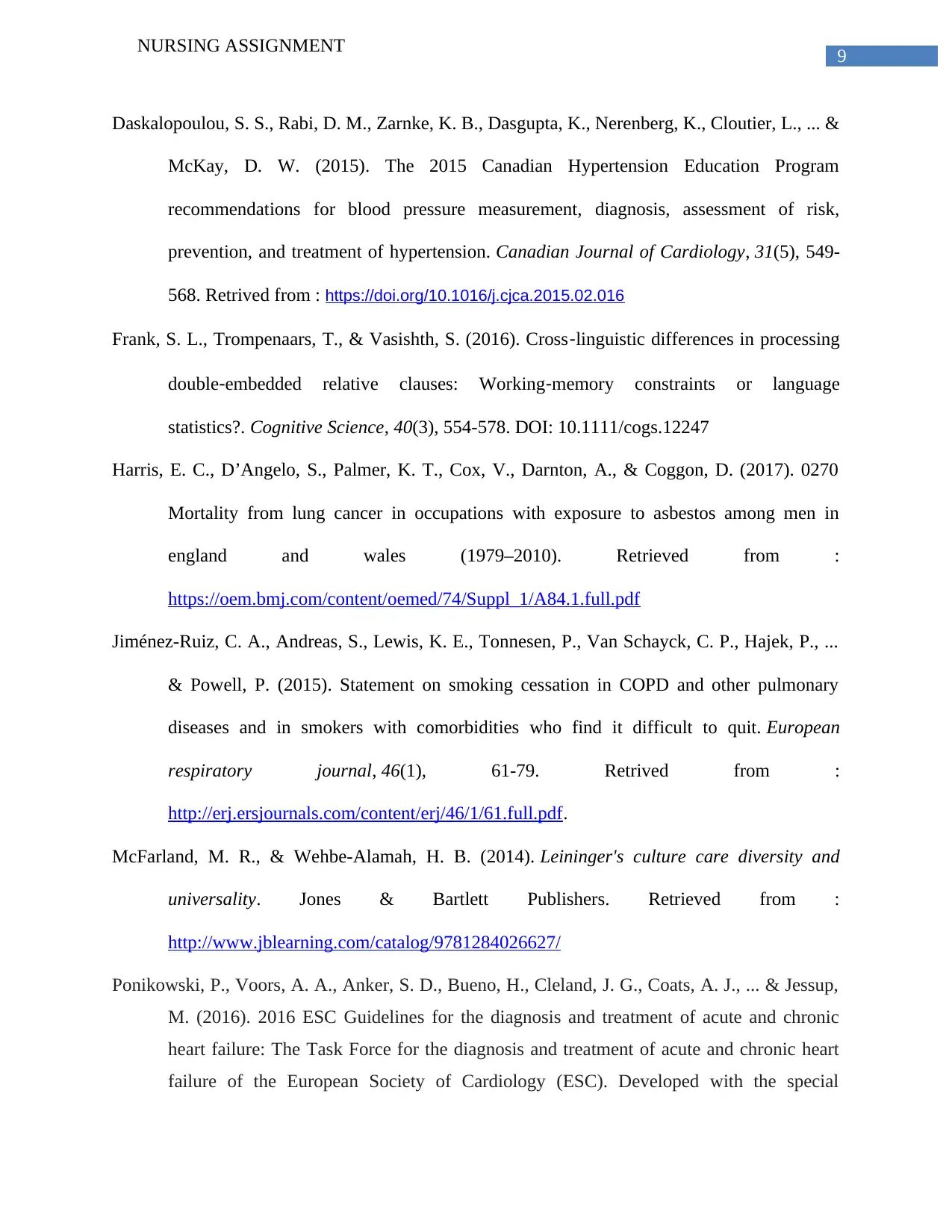
9
NURSING ASSIGNMENT
Daskalopoulou, S. S., Rabi, D. M., Zarnke, K. B., Dasgupta, K., Nerenberg, K., Cloutier, L., ... &
McKay, D. W. (2015). The 2015 Canadian Hypertension Education Program
recommendations for blood pressure measurement, diagnosis, assessment of risk,
prevention, and treatment of hypertension. Canadian Journal of Cardiology, 31(5), 549-
568. Retrived from : https://doi.org/10.1016/j.cjca.2015.02.016
Frank, S. L., Trompenaars, T., & Vasishth, S. (2016). Cross‐linguistic differences in processing
double‐embedded relative clauses: Working‐memory constraints or language
statistics?. Cognitive Science, 40(3), 554-578. DOI: 10.1111/cogs.12247
Harris, E. C., D’Angelo, S., Palmer, K. T., Cox, V., Darnton, A., & Coggon, D. (2017). 0270
Mortality from lung cancer in occupations with exposure to asbestos among men in
england and wales (1979–2010). Retrieved from :
https://oem.bmj.com/content/oemed/74/Suppl_1/A84.1.full.pdf
Jiménez-Ruiz, C. A., Andreas, S., Lewis, K. E., Tonnesen, P., Van Schayck, C. P., Hajek, P., ...
& Powell, P. (2015). Statement on smoking cessation in COPD and other pulmonary
diseases and in smokers with comorbidities who find it difficult to quit. European
respiratory journal, 46(1), 61-79. Retrived from :
http://erj.ersjournals.com/content/erj/46/1/61.full.pdf.
McFarland, M. R., & Wehbe-Alamah, H. B. (2014). Leininger's culture care diversity and
universality. Jones & Bartlett Publishers. Retrieved from :
http://www.jblearning.com/catalog/9781284026627/
Ponikowski, P., Voors, A. A., Anker, S. D., Bueno, H., Cleland, J. G., Coats, A. J., ... & Jessup,
M. (2016). 2016 ESC Guidelines for the diagnosis and treatment of acute and chronic
heart failure: The Task Force for the diagnosis and treatment of acute and chronic heart
failure of the European Society of Cardiology (ESC). Developed with the special
NURSING ASSIGNMENT
Daskalopoulou, S. S., Rabi, D. M., Zarnke, K. B., Dasgupta, K., Nerenberg, K., Cloutier, L., ... &
McKay, D. W. (2015). The 2015 Canadian Hypertension Education Program
recommendations for blood pressure measurement, diagnosis, assessment of risk,
prevention, and treatment of hypertension. Canadian Journal of Cardiology, 31(5), 549-
568. Retrived from : https://doi.org/10.1016/j.cjca.2015.02.016
Frank, S. L., Trompenaars, T., & Vasishth, S. (2016). Cross‐linguistic differences in processing
double‐embedded relative clauses: Working‐memory constraints or language
statistics?. Cognitive Science, 40(3), 554-578. DOI: 10.1111/cogs.12247
Harris, E. C., D’Angelo, S., Palmer, K. T., Cox, V., Darnton, A., & Coggon, D. (2017). 0270
Mortality from lung cancer in occupations with exposure to asbestos among men in
england and wales (1979–2010). Retrieved from :
https://oem.bmj.com/content/oemed/74/Suppl_1/A84.1.full.pdf
Jiménez-Ruiz, C. A., Andreas, S., Lewis, K. E., Tonnesen, P., Van Schayck, C. P., Hajek, P., ...
& Powell, P. (2015). Statement on smoking cessation in COPD and other pulmonary
diseases and in smokers with comorbidities who find it difficult to quit. European
respiratory journal, 46(1), 61-79. Retrived from :
http://erj.ersjournals.com/content/erj/46/1/61.full.pdf.
McFarland, M. R., & Wehbe-Alamah, H. B. (2014). Leininger's culture care diversity and
universality. Jones & Bartlett Publishers. Retrieved from :
http://www.jblearning.com/catalog/9781284026627/
Ponikowski, P., Voors, A. A., Anker, S. D., Bueno, H., Cleland, J. G., Coats, A. J., ... & Jessup,
M. (2016). 2016 ESC Guidelines for the diagnosis and treatment of acute and chronic
heart failure: The Task Force for the diagnosis and treatment of acute and chronic heart
failure of the European Society of Cardiology (ESC). Developed with the special
Secure Best Marks with AI Grader
Need help grading? Try our AI Grader for instant feedback on your assignments.
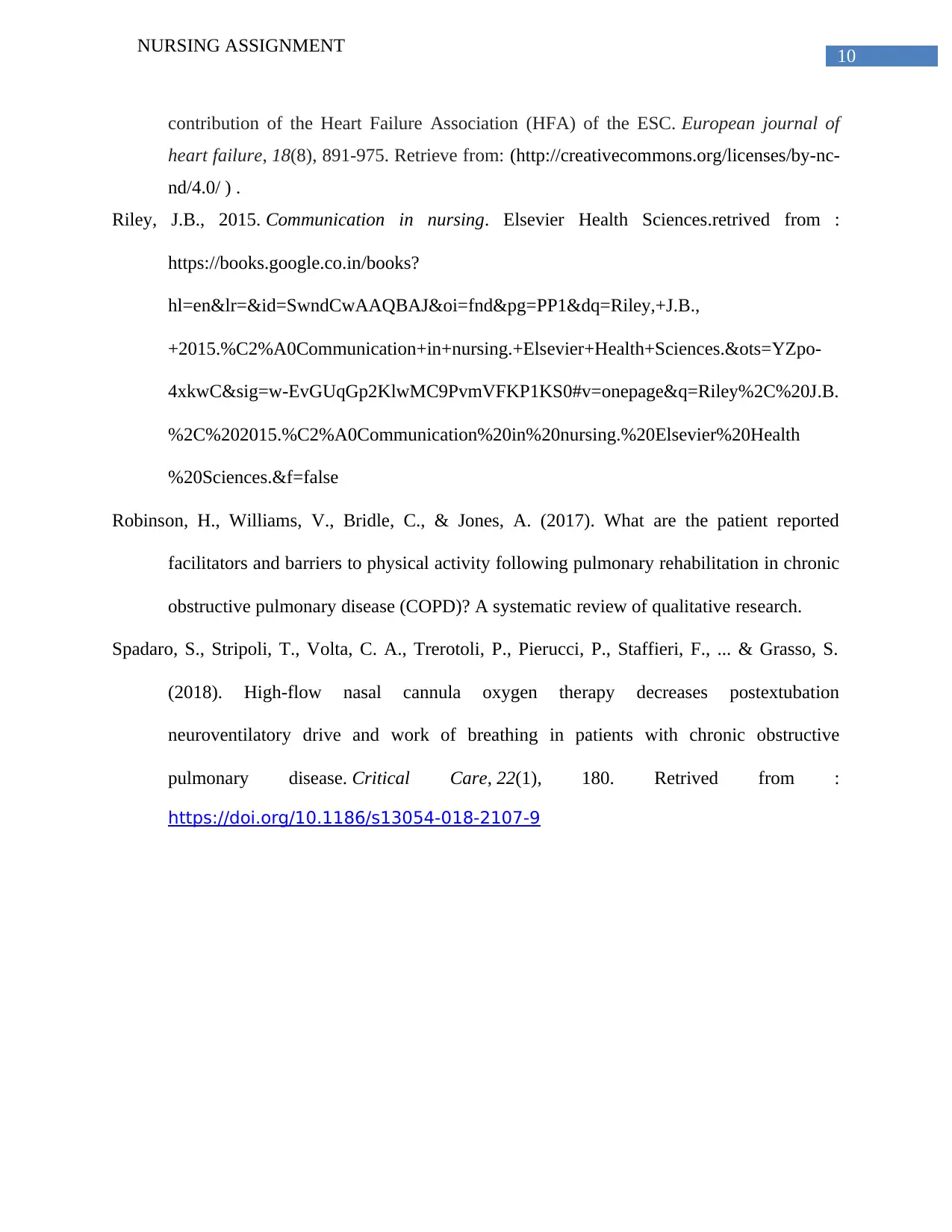
10
NURSING ASSIGNMENT
contribution of the Heart Failure Association (HFA) of the ESC. European journal of
heart failure, 18(8), 891-975. Retrieve from: (http://creativecommons.org/licenses/by-nc-
nd/4.0/ ) .
Riley, J.B., 2015. Communication in nursing. Elsevier Health Sciences.retrived from :
https://books.google.co.in/books?
hl=en&lr=&id=SwndCwAAQBAJ&oi=fnd&pg=PP1&dq=Riley,+J.B.,
+2015.%C2%A0Communication+in+nursing.+Elsevier+Health+Sciences.&ots=YZpo-
4xkwC&sig=w-EvGUqGp2KlwMC9PvmVFKP1KS0#v=onepage&q=Riley%2C%20J.B.
%2C%202015.%C2%A0Communication%20in%20nursing.%20Elsevier%20Health
%20Sciences.&f=false
Robinson, H., Williams, V., Bridle, C., & Jones, A. (2017). What are the patient reported
facilitators and barriers to physical activity following pulmonary rehabilitation in chronic
obstructive pulmonary disease (COPD)? A systematic review of qualitative research.
Spadaro, S., Stripoli, T., Volta, C. A., Trerotoli, P., Pierucci, P., Staffieri, F., ... & Grasso, S.
(2018). High-flow nasal cannula oxygen therapy decreases postextubation
neuroventilatory drive and work of breathing in patients with chronic obstructive
pulmonary disease. Critical Care, 22(1), 180. Retrived from :
https://doi.org/10.1186/s13054-018-2107-9
NURSING ASSIGNMENT
contribution of the Heart Failure Association (HFA) of the ESC. European journal of
heart failure, 18(8), 891-975. Retrieve from: (http://creativecommons.org/licenses/by-nc-
nd/4.0/ ) .
Riley, J.B., 2015. Communication in nursing. Elsevier Health Sciences.retrived from :
https://books.google.co.in/books?
hl=en&lr=&id=SwndCwAAQBAJ&oi=fnd&pg=PP1&dq=Riley,+J.B.,
+2015.%C2%A0Communication+in+nursing.+Elsevier+Health+Sciences.&ots=YZpo-
4xkwC&sig=w-EvGUqGp2KlwMC9PvmVFKP1KS0#v=onepage&q=Riley%2C%20J.B.
%2C%202015.%C2%A0Communication%20in%20nursing.%20Elsevier%20Health
%20Sciences.&f=false
Robinson, H., Williams, V., Bridle, C., & Jones, A. (2017). What are the patient reported
facilitators and barriers to physical activity following pulmonary rehabilitation in chronic
obstructive pulmonary disease (COPD)? A systematic review of qualitative research.
Spadaro, S., Stripoli, T., Volta, C. A., Trerotoli, P., Pierucci, P., Staffieri, F., ... & Grasso, S.
(2018). High-flow nasal cannula oxygen therapy decreases postextubation
neuroventilatory drive and work of breathing in patients with chronic obstructive
pulmonary disease. Critical Care, 22(1), 180. Retrived from :
https://doi.org/10.1186/s13054-018-2107-9
1 out of 11
Related Documents
Your All-in-One AI-Powered Toolkit for Academic Success.
+13062052269
info@desklib.com
Available 24*7 on WhatsApp / Email
![[object Object]](/_next/static/media/star-bottom.7253800d.svg)
Unlock your academic potential
© 2024 | Zucol Services PVT LTD | All rights reserved.




